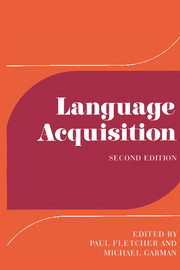Book contents
- Frontmatter
- Contents
- Contributors
- Preface
- Part I Contexts and determinants
- Introduction
- 1 Psychosocial aspects of language acquisition
- 2 Language acquisition and cognition
- 3 Language acquisition and linguistic theory
- 4 Conversations with children
- 5 Learnability
- 6 Variation in child language
- Part II The development of linguistic systems: phonology
- Part III The development of linguistic systems: grammar
- Part IV Later language development
- Notes to chapters
- Bibliography and citation index
- General index
- Titles in the series
1 - Psychosocial aspects of language acquisition
Published online by Cambridge University Press: 05 June 2012
- Frontmatter
- Contents
- Contributors
- Preface
- Part I Contexts and determinants
- Introduction
- 1 Psychosocial aspects of language acquisition
- 2 Language acquisition and cognition
- 3 Language acquisition and linguistic theory
- 4 Conversations with children
- 5 Learnability
- 6 Variation in child language
- Part II The development of linguistic systems: phonology
- Part III The development of linguistic systems: grammar
- Part IV Later language development
- Notes to chapters
- Bibliography and citation index
- General index
- Titles in the series
Summary
Introduction
Language acquisition does not take place in a vacuum. As children acquire language, they acquire a sign system which bears important relationships to both cognitive and social aspects of their life. The issues involved in assessing the inter-relationships among social, linguistic, and cognitive processes in development are numerous, and no attempt is made here to present them exhaustively. As a starting point, this chapter considers the status of language in two developmental theories, Piaget's and Vygotsky's, in relation to cognitive and social-interactive processes. This brief contrast shows that the importance which is attributed to social interaction in Vygotsky's theory, and its relatively secondary role in Piaget's theory, result partly from the different ways in which they define language and interpret its development. More generally, the discussion highlights the implications of viewing language and its development as either intrinsically tied to, or as relatively autonomous from, its social-interactive context of use. It presents some of the issues involved in making inferences from child language about cognitive and social development, suggesting some implications of recent research on the functional properties of child language and on its contextual determinants.
Most theories of child development address in one way or another the question of how language, thought, and social interaction interrelate in the child's life. Depending on the particular focus of each theory, these three aspects of development can be defined and related differently.
- Type
- Chapter
- Information
- Language AcquisitionStudies in First Language Development, pp. 9 - 29Publisher: Cambridge University PressPrint publication year: 1986
- 2
- Cited by



